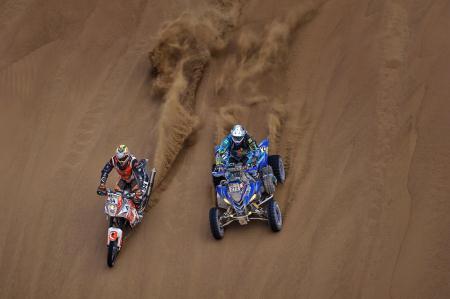2: marathon stages (bikes and quads) without assistance and totally independent (2,702 km including 1,590 km of special stages). – 4: the number of titles to be won on the Dakar, in the bike, quad, car and truck categories. – 9: the number of women registered on the Dakar in the car, bike and quad categories. – 11: the record for rally victories, held by Stéphane Peterhansel, with 6 titles on a bike and 5 in a car. Vladimir Chagin boasts the record number of victories in a single category, with 7 triumphs in a truck. – 18, 23: in years and days, the age of the youngest rider at the start in Rosario, Argentinean Jeremías González Ferioli, participating in the quad category. – 28: the number of countries visited by the Dakar since its creation. Bolivia will be welcoming the rally for the first time, hosting two stages.
30: the number of doctors present at the field hospital, for the riders, drivers and organisation teams.
41: the number of quad riders registered for the rally in 2014, a record.
50: the number of nationalities represented on the rally.
60: the number of secure zones for spectators.
71: the number of trucks participating in the rally.
72: in years, the age of the rally’s oldest competitor, Japan’s Yoshimasa Sugawara, in a truck.
89: the number of competitors taking part in the Dakar for the first time, i.e. 20.27% of the total.
124: the number of French competitors involved in the race, the leading nationality, with 17.29% of the total.
152: the number of cars taking part in the rally.
190: the number of countries in which the images of the Dakar will be broadcast, by 70 TV broadcasters.
210: the number of organisation vehicles used daily on the rally (40 cars, 11 helicopters, 55 trucks, 5 buses, etc.).
280: the number of journalists who will follow the entire rally, out of 1,800 granted media passes in total in the media family (technicians, consultants, day pass holders, etc.).
450: in CC, the maximum power authorised for the engines on the motorbikes enrolled on the rally.
720: the number of competitors involved as riders, drivers, co-pilots and mechanics.
1,200: in total, the estimated number of hours broadcast of images of the Dakar on the world’s TV channels (based on figures from 2013).
1978: on 26th December of that year, the start of the 1st edition took place, for the 1979 vintage
2,300: the number of safety messages broadcast on 40 radio stations in Argentina, Chile and Bolivia.
3,000: the number of people welcomed each day to the bivouac: competitors, organisers, sponsors and media personnel.
8,739: the number of kilometres to be covered between Rosario and Santiago, with 5,220 kilometres of special stages for the cars.
9,209: the number of kilometres to be covered between Rosario and Santiago, with 5,212 kilometres of special stages for the trucks.
9395: the number of kilometres to be covered between Rosario and Santiago, with 5,222 kilometres of special stages for the bikes.
22,000: the number of people mobilised for the safety of the spectators and competitors.
80,000: the number of meals served at the bivouac during the duration of the rally.
100,000: the number of followers on the Dakar’s official Twitter feed.
820,000: the number of fans on the Dakar’s official Facebook page, several days before the start of the race.
7.8 million: the number of unique visitors to the www.dakar.com web site.
4.6 million: the number of spectators counted for the start, finish and passage of the Dakar in 2013, in Argentina, Chile and Peru.
1 billion: the number of TV viewers that watched images of the Dakar in 2013


